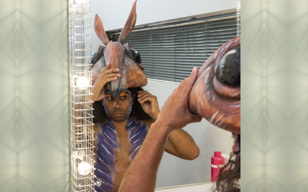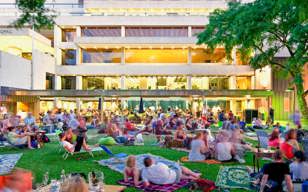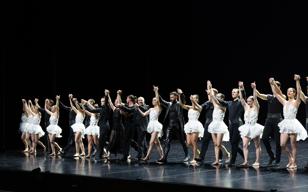Published: 22 February 2019
“Love, too, has to be learned.” Friedrich Nietzsche
LOVE IN THE CLASSROOM
I first encounter Letitia at the door acting like a Greek sentinel. She greets us, no, stops us, insisting on inspecting our car keys. It’s a silent and intense exchange between this classroom guardian, and Sally, Angela and me, visiting teaching artists arriving to rehearse a dance performance. Sally dutifully hands over the keys and mercifully, the insignia assures Letitia it’s the Nissan Pulsar, it’s the car she recognises. Phew... it’s what she’s expecting, we’re allowed to enter. I clock how physically beautiful she is, eight perhaps nine, with shoulder length blond wispy hair. She looks a lot like one of the Christmas angels laced onto the classroom rafters.
It’s evident we’re expected, and the atmosphere is buoyant as 15 children and four teachers welcome us. They’re ready and waiting, raring to perform. Seated in two forward facing rows, each dancer holds a continuous length of rope which interconnects them front to back. With music cued the dance begins.
From the beginning it’s clear that this is no ordinary dance class.
Letitia, our sentinel moves unassisted, and the dance flows. But I see she’s beginning to cry and it breaks her rhythm. She’s missed her cue and this seems to have upset her. Her lips quiver and tears roll down her angelic face. I suspect her tears are a mixture of fury and frustration directed inwards. The change from Christmas angel to fractured angel is deeply affecting.
She cries and then she doesn’t, an infinitesimal moment of humanity.
Without encouragement the classroom teachers tell us how important these dance classes are for their children. And there’s an added pleasure imminent, a visit to the professional studio an opportunity to perform publicly with full production values.
They speak quietly but passionately wanting us to know how dancing is a special way into the minds and bodies of their children. They mention the sheer joy of the creative act, but there’s more, much more because when curriculum is felt kinaesthetically, bodily, it helps to reach their children’s additional needs.
Ann, the lead teacher demonstrates by repeating a piece of the performance “see how by dragging our feet in the sand we imagine it”. And then, “how far are our feet apart?” – offers entrees into maths. “Can you write a poem about feeling the sand beneath your toes?” – English. And more – geography, health and physical education.
As we prepare to leave, Ann quietly whispers, “before dance classes it was impossible for Letitia to be near any female without wanting to scratch their eyes out, she simply couldn’t make friends”.
Letitia’s story makes me think about love, apposite for all children, for all people. I’m proposing that, across a lifetime, love is the only thing worth having faith in.

Illustration: Jula Borzucka, Photo: Piotr Matey
LOVE IN THE THEATRE
A counterpoint to Letitia’s arts experience is the musical The Book of Mormon. Through the musical’s outrageousness it explores what and where we place our faith and beliefs. The term ‘a good life’ is a secular euphemism for speaking about faith and beliefs, terms more usually associated with religious contexts. Traditionally rationales for a good life are found in religious and philosophical teachings of leaders such as Confucius, Buddha, Muhammad, Socrates, Plato, Aristotle, and monotheistic religion not classrooms or musicals.
In The Book of Mormon, creators Bobby Lopez, Matt Stone and Trey Parker irreverently introduce one such credo, as explored in the Christian Bible plus a third part, said to be dug from the earth by Joseph Smith the Mormon founder.
We learn that “there’s a part three to the bible… and I God have anointed you to dig up this part three, which is buried by a tree on the hill in your backyard”.
Predicated on the idea that one man’s blasphemy is another man’s scripture, the young Mormon evangelists convolute biblical stories with hilarious but sincere intentions to convert the village people of Uganda. Elder Cunningham, the protagonist of the piece falls in love with village girl Nabulungi and together they create preposterous mis-truths to convert the Ugandan villagers.
Both creators and performers show no restraint in satirising Mormon beliefs in service of the narrative. Whilst we laugh at the lyrics of a song like I Believe based on the beliefs of The Church of the Latter-Day Saints, we never laugh at the evangelists themselves as they sing:
The Scriptures say that if you ask in faith,
If you ask God Himself he’ll know.
But you must ask Him without any doubt
And let your spirit grow...
I believe that God lives on a planet called Kolob.
I believe that Jesus has his own planet as well.
And I believe that the Garden of Eden was
in Jackson County, Missouri.
If you believe, the Lord will reveal it.
And you’ll know it's all true. You’ll just feel it.
You’ll be a Mormon
Lopez, Stone and Parker’s musical introduces these goofy, well-meaning young men whose inner lives are full of noble intentions and fantastical stories. Whatever one’s beliefs in the sanctity of their mission to convert others to their faith, what the characters offer are portraits of young men living their best lives, a good life.
The creators of The Book of Mormon tap into Elder Cunningham’s loss of faith and when the musical finishes he’s found “a renewed faith, more adult, more integrated set of beliefs”. Letitia’s faith is unspoken, but her sentinel behaviour implies that the classroom has special significance for her.
After seeing The Book of Mormon I left the theatre with mixed emotions laughing at the giftedness of creative people, who can so lovingly yet savagely ridicule a set of religious beliefs while maintaining a healthy respect for the people who make up The Church of the Latter-Day Saints. After leaving the classroom I was upset, fighting off tears but checked myself as Letitia monitored our departure, ever the sentinel.
Neither Letitia nor the Elders need our pity for their situations. Rather than ridicule or tears, what both need is people who believe in them, to be loved whatever their beliefs.
In the weeks around my classroom visit and attending The Book of Mormon, I was reading French philosopher Luc Ferry’s challenging book On Love exploring how circumstantial faith has been over the centuries. No matter how human understanding of the term faith has morphed, the one constant that belongs to all creeds, dogmas and faiths is love.
In it, Ferry quotes the writer Stendhal, “love has always been... the greatest thing of all... or rather the only thing!” in support of his argument that love isn’t just one feeling amongst others, that in the 21st century love is a new principle of meaning, “a principle that shapes a completely new conception of a good life”.

Professor Judith McLean
Professor Judith McLean is the Chair in Arts Education, a joint appointment between Queensland University of Technology (QUT) and the Queensland Performing Arts Centre (QPAC) where she held the role of Scholar in Residence until September 2021. Judith’s career is distinguished by her breadth and diversity of experience as an arts educator, artist and cultural leader across Australia. She is a member of the Australia Council’s Major Performing Arts Panel and Chair of Dancenorth, a contemporary dance company based in Townsville.
You May Also Like

Behind the Scenes
Our Behind the Scenes series takes you on an exclusive journey into the heart of QPAC, where the magic of the stage comes to life.

Projects and Events
QPAC is a creative hub where communities come together to celebrate, learn, and grow through the transformative power of the arts.

Digital Stage
On-demand performances, live streams and behind-the-scenes.

Support
Support QPAC to help nurture and celebrate Queensland's rich artistic heritage while fostering innovation and creativity for the future.


